2006 DODGE RAM SRT-10 oil change
[x] Cancel search: oil changePage 3235 of 5267
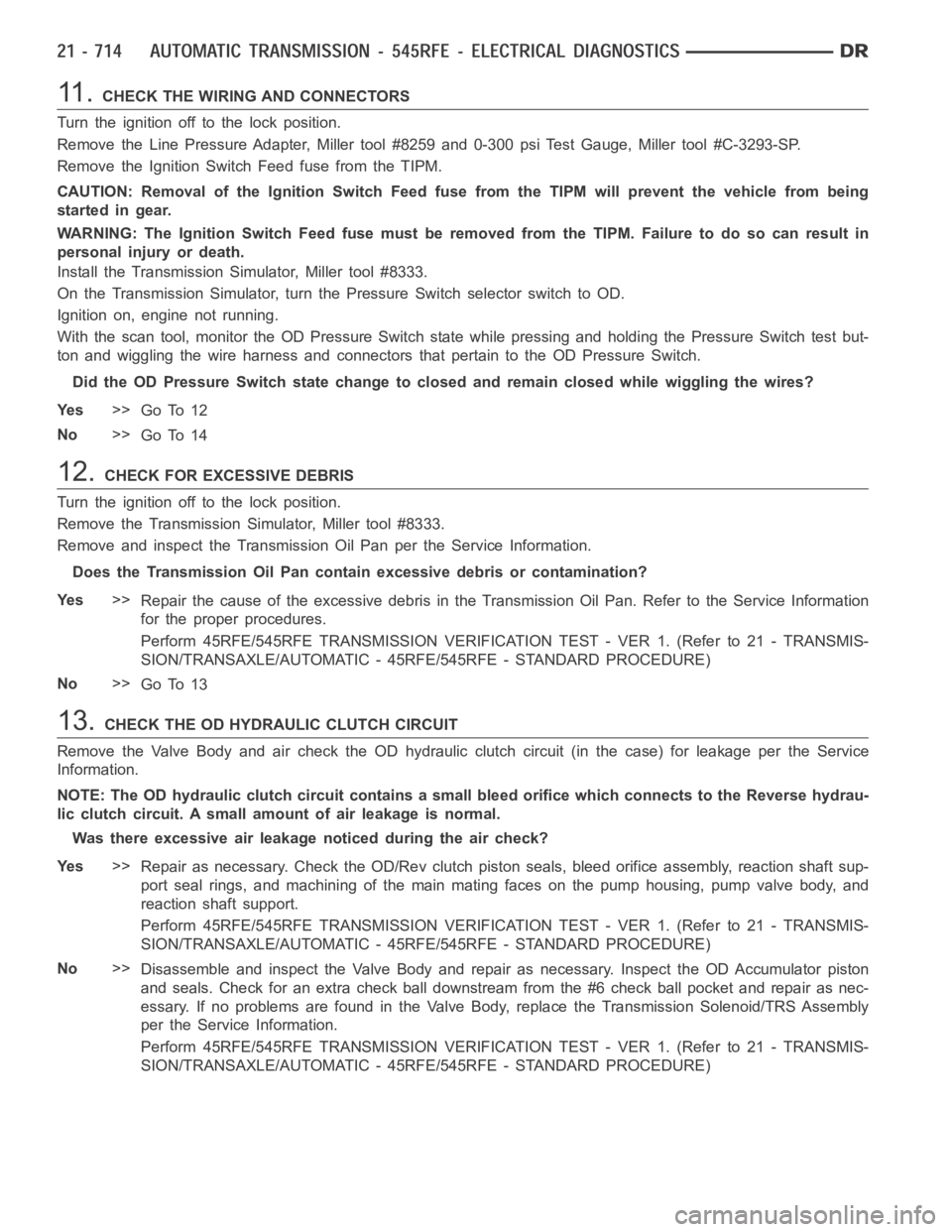
11 .CHECK THE WIRING AND CONNECTORS
Turn the ignition off to the lock position.
Remove the Line Pressure Adapter, Miller tool #8259 and 0-300 psi Test Gauge, Miller tool #C-3293-SP.
Remove the Ignition Switch Feed fuse from the TIPM.
CAUTION: Removal of the Ignition Switch Feed fuse from the TIPM will prevent the vehicle from being
startedingear.
WARNING: The Ignition Switch Feed fuse must be removed from the TIPM. Failure to do so can result in
personal injury or death.
Install the Transmission Simulator, Miller tool #8333.
On the Transmission Simulator, turn the Pressure Switch selector switch toOD.
Ignition on, engine not running.
With the scan tool, monitor the OD Pressure Switch state while pressing andholding the Pressure Switch test but-
ton and wiggling the wire harness and connectors that pertain to the OD Pressure Switch.
Did the OD Pressure Switch state change to closed and remain closed while wiggling the wires?
Ye s>>
Go To 12
No>>
Go To 14
12.CHECK FOR EXCESSIVE DEBRIS
Turn the ignition off to the lock position.
Remove the Transmission Simulator, Miller tool #8333.
Remove and inspect the Transmission Oil Pan per the Service Information.
Does the Transmission Oil Pan contain excessive debris or contamination?
Ye s>>
Repair the cause of the excessive debris in the Transmission Oil Pan. Referto the Service Information
for the proper procedures.
Perform 45RFE/545RFE TRANSMISSION VERIFICATION TEST - VER 1. (Refer to 21- TRANSMIS-
SION/TRANSAXLE/AUTOMATIC - 45RFE/545RFE - STANDARD PROCEDURE)
No>>
Go To 13
13.CHECK THE OD HYDRAULIC CLUTCH CIRCUIT
Remove the Valve Body and air check the OD hydraulic clutch circuit (in the case) for leakage per the Service
Information.
NOTE: The OD hydraulic clutch circuitcontains a small bleed orifice whichconnects to the Reverse hydrau-
lic clutch circuit. A small amount of air leakage is normal.
Was there excessive air leakage noticed during the air check?
Ye s>>
Repair as necessary. Check the OD/Rev clutch piston seals, bleed orifice assembly, reaction shaft sup-
port seal rings, and machining of the main mating faces on the pump housing,pump valve body, and
reaction shaft support.
Perform 45RFE/545RFE TRANSMISSION VERIFICATION TEST - VER 1. (Refer to 21- TRANSMIS-
SION/TRANSAXLE/AUTOMATIC - 45RFE/545RFE - STANDARD PROCEDURE)
No>>
Disassemble and inspect the Valve Body and repair as necessary. Inspect the OD Accumulator piston
and seals. Check for an extra check ball downstream from the #6 check ball pocket and repair as nec-
essary. If no problems are found in the Valve Body, replace the Transmission Solenoid/TRS Assembly
per the Service Information.
Perform 45RFE/545RFE TRANSMISSION VERIFICATION TEST - VER 1. (Refer to 21- TRANSMIS-
SION/TRANSAXLE/AUTOMATIC - 45RFE/545RFE - STANDARD PROCEDURE)
Page 3243 of 5267
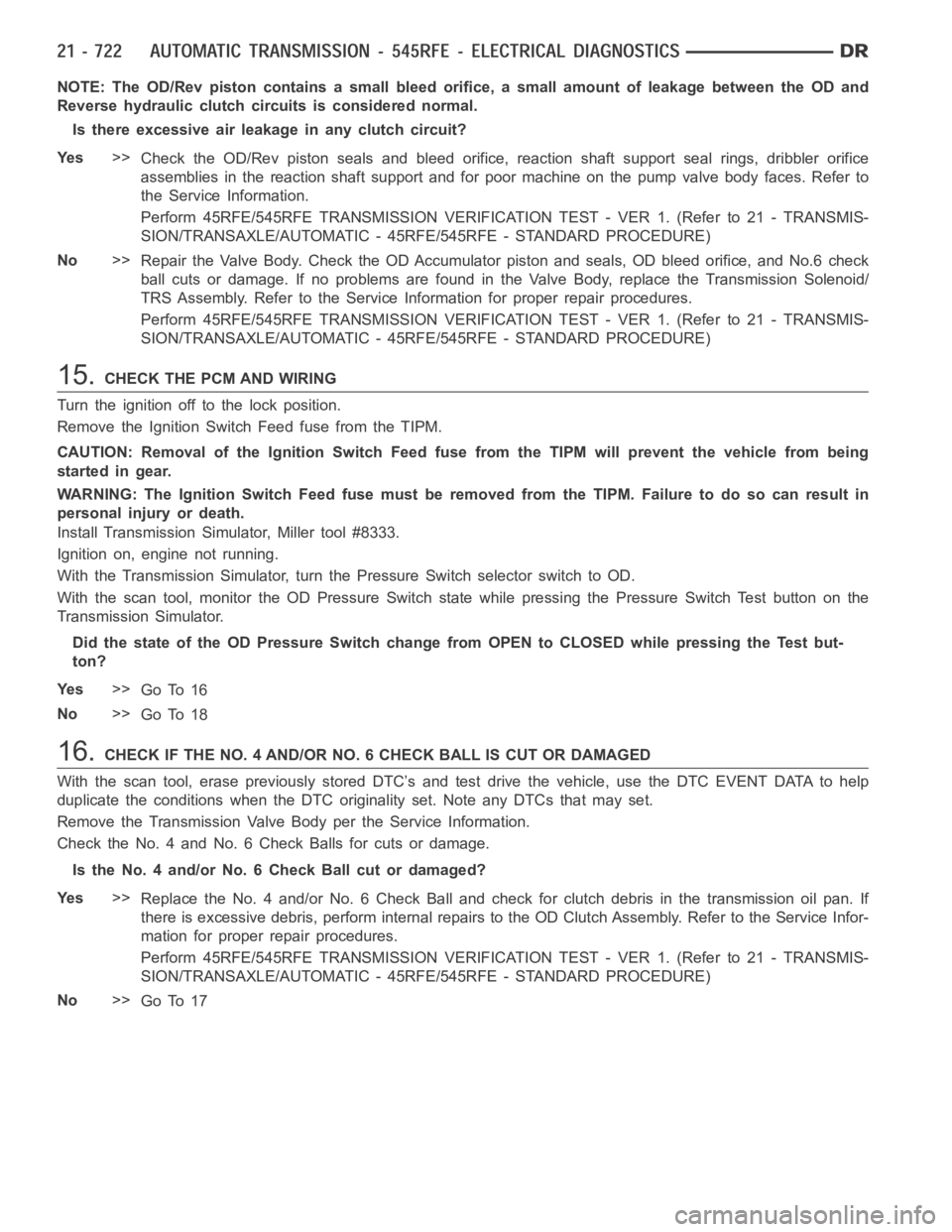
NOTE: The OD/Rev piston contains a small bleed orifice, a small amount of leakage between the OD and
Reverse hydraulic clutch circuits is considered normal.
Is there excessive air leakage in any clutch circuit?
Ye s>>
Check the OD/Rev piston seals and bleed orifice, reaction shaft support seal rings, dribbler orifice
assemblies in the reaction shaft support and for poor machine on the pump valve body faces. Refer to
the Service Information.
Perform 45RFE/545RFE TRANSMISSION VERIFICATION TEST - VER 1. (Refer to 21- TRANSMIS-
SION/TRANSAXLE/AUTOMATIC - 45RFE/545RFE - STANDARD PROCEDURE)
No>>
Repair the Valve Body. Check the OD Accumulator piston and seals, OD bleed orifice, and No.6 check
ball cuts or damage. If no problems are found in the Valve Body, replace the Transmission Solenoid/
TRS Assembly. Refer to the Service Information for proper repair procedures.
Perform 45RFE/545RFE TRANSMISSION VERIFICATION TEST - VER 1. (Refer to 21- TRANSMIS-
SION/TRANSAXLE/AUTOMATIC - 45RFE/545RFE - STANDARD PROCEDURE)
15.CHECK THE PCM AND WIRING
Turn the ignition off to the lock position.
Remove the Ignition Switch Feed fuse from the TIPM.
CAUTION: Removal of the Ignition Switch Feed fuse from the TIPM will prevent the vehicle from being
startedingear.
WARNING: The Ignition Switch Feed fuse must be removed from the TIPM. Failure to do so can result in
personal injury or death.
Install Transmission Simulator, Miller tool #8333.
Ignition on, engine not running.
With the Transmission Simulator, turn the Pressure Switch selector switchtoOD.
With the scan tool, monitor the OD Pressure Switch state while pressing thePressure Switch Test button on the
Transmission Simulator.
Did the state of the OD Pressure Switch change from OPEN to CLOSED while pressing the Test but-
ton?
Ye s>>
Go To 16
No>>
Go To 18
16.CHECK IF THE NO. 4 AND/OR NO. 6 CHECK BALL IS CUT OR DAMAGED
With the scan tool, erase previously stored DTC’s and test drive the vehicle, use the DTC EVENT DATA to help
duplicate the conditions when the DTC originality set. Note any DTCs that may set.
Remove the Transmission Valve Body per the Service Information.
Check the No. 4 and No. 6 Check Balls for cuts or damage.
Is the No. 4 and/or No. 6 Check Ball cut or damaged?
Ye s>>
Replace the No. 4 and/or No. 6 Check Ball and check for clutch debris in the transmission oil pan. If
there is excessive debris, perform internal repairs to the OD Clutch Assembly. Refer to the Service Infor-
mation for proper repair procedures.
Perform 45RFE/545RFE TRANSMISSION VERIFICATION TEST - VER 1. (Refer to 21- TRANSMIS-
SION/TRANSAXLE/AUTOMATIC - 45RFE/545RFE - STANDARD PROCEDURE)
No>>
Go To 17
Page 3252 of 5267
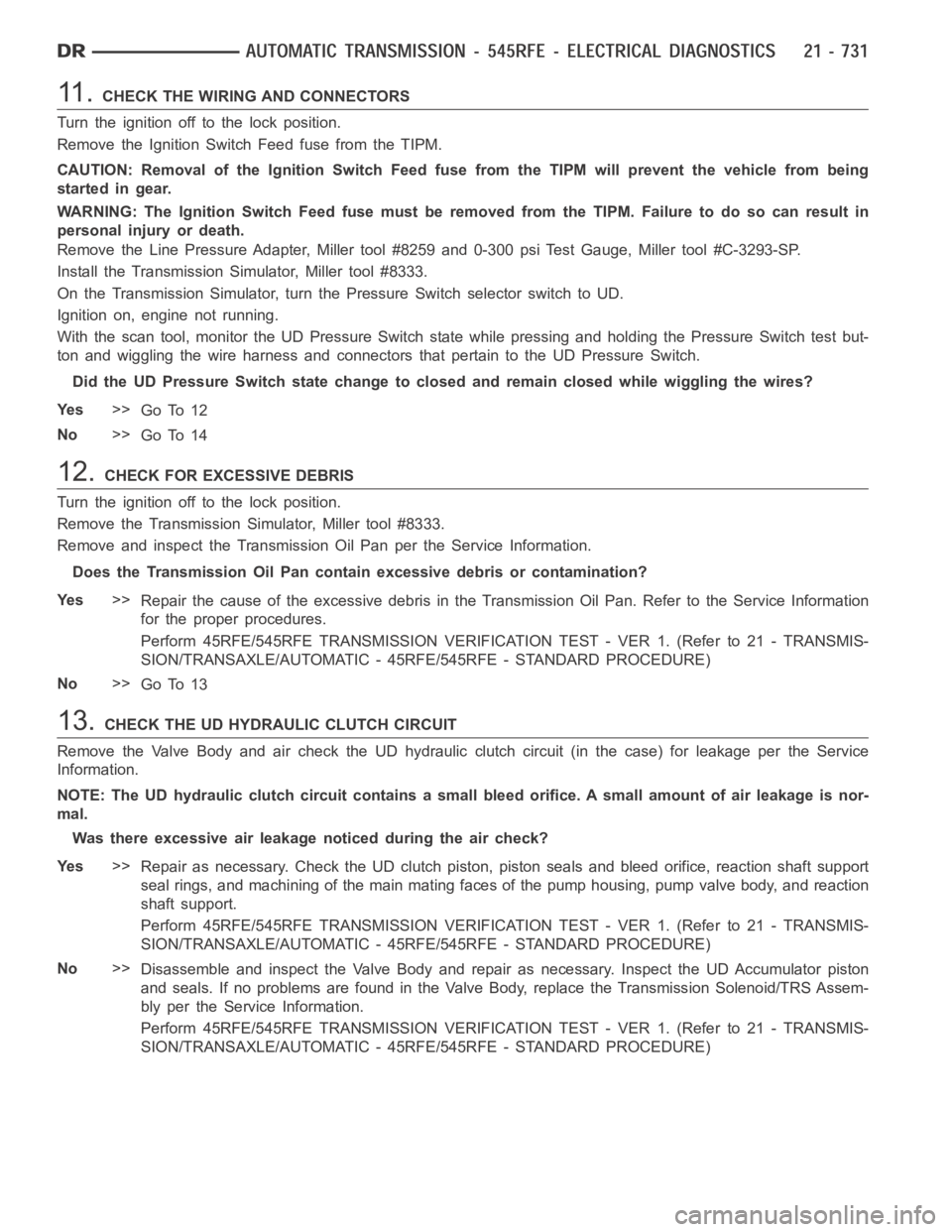
11 .CHECK THE WIRING AND CONNECTORS
Turn the ignition off to the lock position.
Remove the Ignition Switch Feed fuse from the TIPM.
CAUTION: Removal of the Ignition Switch Feed fuse from the TIPM will prevent the vehicle from being
startedingear.
WARNING: The Ignition Switch Feed fuse must be removed from the TIPM. Failure to do so can result in
personal injury or death.
Remove the Line Pressure Adapter, Miller tool #8259 and 0-300 psi Test Gauge, Miller tool #C-3293-SP.
Install the Transmission Simulator, Miller tool #8333.
On the Transmission Simulator, turn the Pressure Switch selector switch to UD.
Ignition on, engine not running.
With the scan tool, monitor the UD Pressure Switch state while pressing andholding the Pressure Switch test but-
ton and wiggling the wire harness and connectors that pertain to the UD Pressure Switch.
Did the UD Pressure Switch state change to closed and remain closed while wiggling the wires?
Ye s>>
Go To 12
No>>
Go To 14
12.CHECK FOR EXCESSIVE DEBRIS
Turn the ignition off to the lock position.
Remove the Transmission Simulator, Miller tool #8333.
Remove and inspect the Transmission Oil Pan per the Service Information.
Does the Transmission Oil Pan contain excessive debris or contamination?
Ye s>>
Repair the cause of the excessive debris in the Transmission Oil Pan. Referto the Service Information
for the proper procedures.
Perform 45RFE/545RFE TRANSMISSION VERIFICATION TEST - VER 1. (Refer to 21- TRANSMIS-
SION/TRANSAXLE/AUTOMATIC - 45RFE/545RFE - STANDARD PROCEDURE)
No>>
Go To 13
13.CHECK THE UD HYDRAULIC CLUTCH CIRCUIT
Remove the Valve Body and air check the UD hydraulic clutch circuit (in the case) for leakage per the Service
Information.
NOTE: The UD hydraulic clutch circuit contains a small bleed orifice. A small amount of air leakage is nor-
mal.
Was there excessive air leakage noticed during the air check?
Ye s>>
Repair as necessary. Check the UD clutch piston, piston seals and bleed orifice, reaction shaft support
seal rings, and machining of the main mating faces of the pump housing, pumpvalve body, and reaction
shaft support.
Perform 45RFE/545RFE TRANSMISSION VERIFICATION TEST - VER 1. (Refer to 21- TRANSMIS-
SION/TRANSAXLE/AUTOMATIC - 45RFE/545RFE - STANDARD PROCEDURE)
No>>
Disassemble and inspect the Valve Body and repair as necessary. Inspect the UD Accumulator piston
and seals. If no problems are found in the Valve Body, replace the Transmission Solenoid/TRS Assem-
bly per the Service Information.
Perform 45RFE/545RFE TRANSMISSION VERIFICATION TEST - VER 1. (Refer to 21- TRANSMIS-
SION/TRANSAXLE/AUTOMATIC - 45RFE/545RFE - STANDARD PROCEDURE)
Page 3296 of 5267
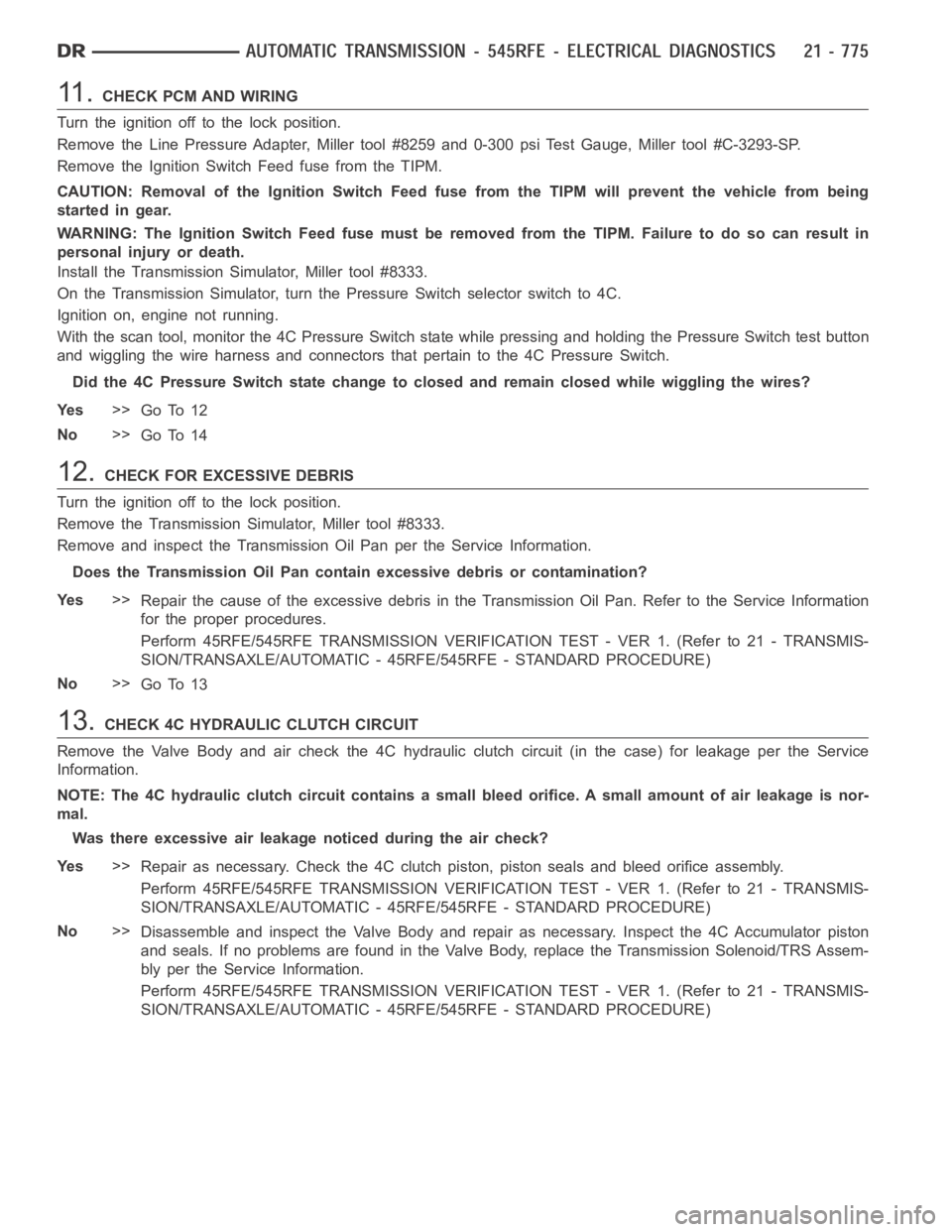
11 .CHECK PCM AND WIRING
Turn the ignition off to the lock position.
Remove the Line Pressure Adapter, Miller tool #8259 and 0-300 psi Test Gauge, Miller tool #C-3293-SP.
Remove the Ignition Switch Feed fuse from the TIPM.
CAUTION: Removal of the Ignition Switch Feed fuse from the TIPM will prevent the vehicle from being
startedingear.
WARNING: The Ignition Switch Feed fuse must be removed from the TIPM. Failure to do so can result in
personal injury or death.
Install the Transmission Simulator, Miller tool #8333.
On the Transmission Simulator, turn the Pressure Switch selector switch to4C.
Ignition on, engine not running.
With the scan tool, monitor the 4C Pressure Switch state while pressing andholding the Pressure Switch test button
and wiggling the wire harness and connectors that pertain to the 4C PressureSwitch.
Did the 4C Pressure Switch state change to closed and remain closed while wiggling the wires?
Ye s>>
Go To 12
No>>
Go To 14
12.CHECK FOR EXCESSIVE DEBRIS
Turn the ignition off to the lock position.
Remove the Transmission Simulator, Miller tool #8333.
Remove and inspect the Transmission Oil Pan per the Service Information.
Does the Transmission Oil Pan contain excessive debris or contamination?
Ye s>>
Repair the cause of the excessive debris in the Transmission Oil Pan. Referto the Service Information
for the proper procedures.
Perform 45RFE/545RFE TRANSMISSION VERIFICATION TEST - VER 1. (Refer to 21- TRANSMIS-
SION/TRANSAXLE/AUTOMATIC - 45RFE/545RFE - STANDARD PROCEDURE)
No>>
Go To 13
13.CHECK 4C HYDRAULIC CLUTCH CIRCUIT
Remove the Valve Body and air check the 4C hydraulic clutch circuit (in the case) for leakage per the Service
Information.
NOTE: The 4C hydraulic clutch circuit contains a small bleed orifice. A small amount of air leakage is nor-
mal.
Was there excessive air leakage noticed during the air check?
Ye s>>
Repair as necessary. Check the 4C clutch piston, piston seals and bleed orifice assembly.
Perform 45RFE/545RFE TRANSMISSION VERIFICATION TEST - VER 1. (Refer to 21- TRANSMIS-
SION/TRANSAXLE/AUTOMATIC - 45RFE/545RFE - STANDARD PROCEDURE)
No>>
Disassemble and inspect the Valve Body and repair as necessary. Inspect the 4C Accumulator piston
and seals. If no problems are found in the Valve Body, replace the Transmission Solenoid/TRS Assem-
bly per the Service Information.
Perform 45RFE/545RFE TRANSMISSION VERIFICATION TEST - VER 1. (Refer to 21- TRANSMIS-
SION/TRANSAXLE/AUTOMATIC - 45RFE/545RFE - STANDARD PROCEDURE)
Page 3321 of 5267

P1736-GEAR RATIO ERROR IN 2ND PRIME
For a complete wiring diagramRefer to Section 8W.
When Monitored:
Continuously with the ignition on, engine running, with the transmissionin gear.
Set Condition:
If the ratio of the Input RPM to the Output RPM does not match the current gearratio. This DTC can take up
to five minutes of problem identification before illuminating the MIL
Possible Causes
RELATED DTC’S PRESENT
INPUT SPEED SENSOR OR WIRING
LOW FLUID LEVEL
CRACKED OR MIS-INSTALLED PRIMARY OIL FILTER OR SEAL
WORN SOLENOID SWITCH VALVE OR PLUGS
STUCK OR STICKING MAIN REGULATOR VALVE
BURNED UD OR 4C CLUTCH
CUT 4C OR UD PISTON SEAL
BROKEN 4C PISTON CASTING
BROKEN OR MISSING 4C BLEED ORIFICE
BROKEN OR MISSING UD BLEED ORIFICE
CUT 4C OR UD ACCUMULATOR PISTON SEAL
CRACKED 4C OR UD ACCUMULATOR PISTON
EXTRA CHECK BALL IN PASSAGE DOWNSTREAM OF #7 CHECK BALL POCKET
TRANSMISSION SOLENOID/TRS ASSEMBLY
BROKEN WELD - REACTION CARRIER TO REVERSE SUN GEAR
MISSING TEETH ON INPUT CLUTCH HUB TONE WHEEL
Always perform the 45RFE/545RFE Pre-Diagnostic Troubleshooting Procedure before proceeding. (Refer to
21 - TRANSMISSION/TRANSAXLE/AUTOMATIC - 45RFE/545RFE - STANDARD PROCEDURE)
Theory of Operation
The transmission system uses two speed sensors, one to measure input RPM and one to measure output RPM.
These inputs are essential for proper transmission operation. Therefore, the integrity of this data is verified through
the following checks:
1) When in gear, if the gear ratio does not compare to a known gear ratio, the corresponding in-gear trouble code
is set (DTCs P0731-36).
2) An excessive change in input or output speeds indicating signal intermittent which may result in the DTCs P0715
and/or P0720 to set.
3) If the common speed sensor ground circuit is lost, both sensor inputs will read the signal from the input speed
sensor at idle in neutral. Since the input speed sensor reads 60 teeth from the input clutch hub and the output
speed sensor reads 30 teeth from the park gear, the result is an apparent speed ratio of 1:2 and may cause the
DTC P1794 to set when at a stop.
Page 3328 of 5267
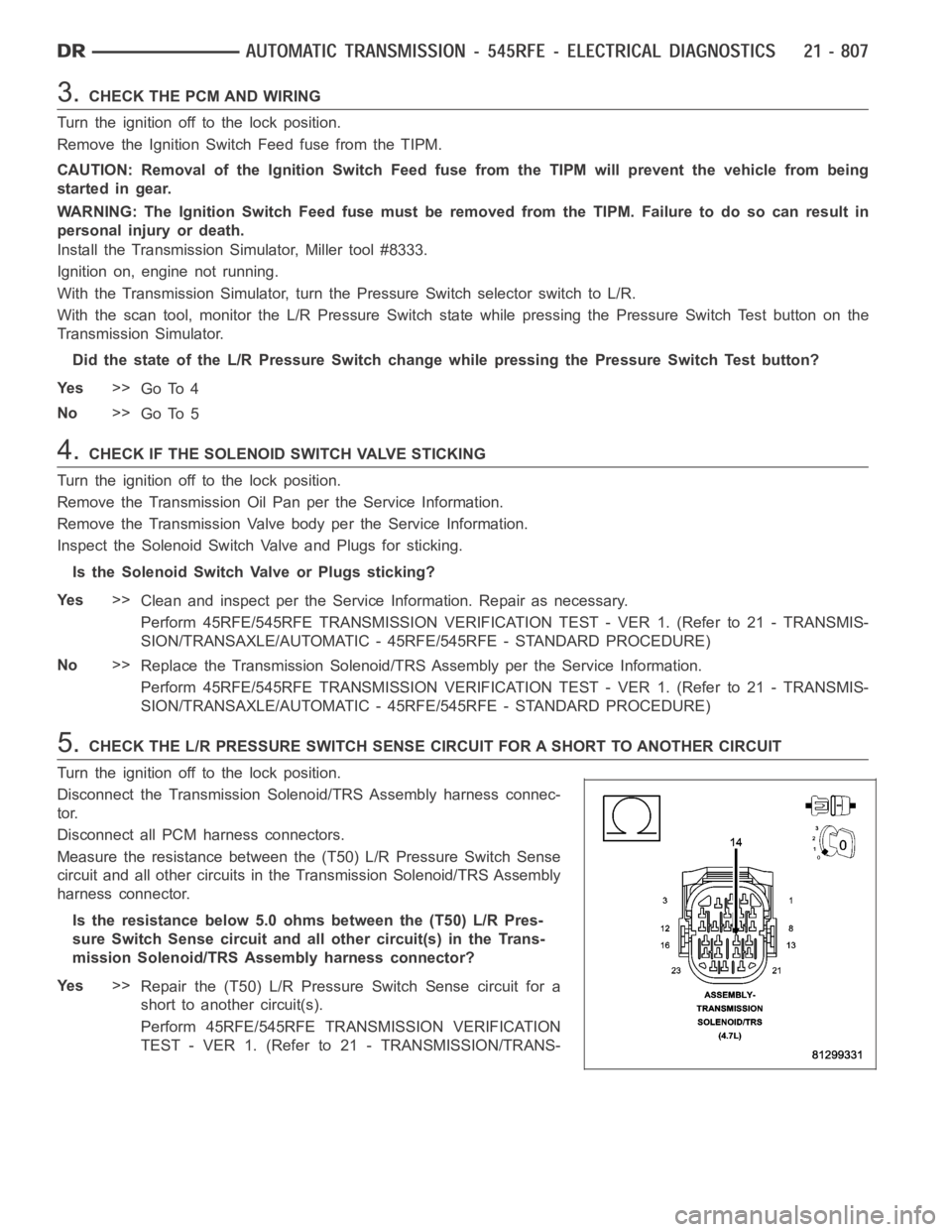
3.CHECK THE PCM AND WIRING
Turn the ignition off to the lock position.
Remove the Ignition Switch Feed fuse from the TIPM.
CAUTION: Removal of the Ignition Switch Feed fuse from the TIPM will prevent the vehicle from being
startedingear.
WARNING: The Ignition Switch Feed fuse must be removed from the TIPM. Failure to do so can result in
personal injury or death.
Install the Transmission Simulator, Miller tool #8333.
Ignition on, engine not running.
With the Transmission Simulator, turn the Pressure Switch selector switchtoL/R.
With the scan tool, monitor the L/R Pressure Switch state while pressing thePressureSwitchTestbuttononthe
Transmission Simulator.
Did the state of the L/R Pressure Switch change while pressing the PressureSwitch Test button?
Ye s>>
Go To 4
No>>
Go To 5
4.CHECK IF THE SOLENOID SWITCH VALVE STICKING
Turn the ignition off to the lock position.
Remove the Transmission Oil Pan per the Service Information.
Remove the Transmission Valve body per the Service Information.
Inspect the Solenoid Switch Valve and Plugs for sticking.
Is the Solenoid Switch Valve or Plugs sticking?
Ye s>>
Clean and inspect per the Service Information. Repair as necessary.
Perform 45RFE/545RFE TRANSMISSION VERIFICATION TEST - VER 1. (Refer to 21- TRANSMIS-
SION/TRANSAXLE/AUTOMATIC - 45RFE/545RFE - STANDARD PROCEDURE)
No>>
Replace the Transmission Solenoid/TRS Assembly per the Service Information.
Perform 45RFE/545RFE TRANSMISSION VERIFICATION TEST - VER 1. (Refer to 21- TRANSMIS-
SION/TRANSAXLE/AUTOMATIC - 45RFE/545RFE - STANDARD PROCEDURE)
5.CHECK THE L/R PRESSURE SWITCH SENSE CIRCUIT FOR A SHORT TO ANOTHER CIRCUIT
Turn the ignition off to the lock position.
Disconnect the Transmission Solenoid/TRS Assembly harness connec-
tor.
Disconnect all PCM harness connectors.
Measure the resistance between the (T50) L/R Pressure Switch Sense
circuit and all other circuits in the Transmission Solenoid/TRS Assembly
harness connector.
Is the resistance below 5.0 ohms between the (T50) L/R Pres-
sure Switch Sense circuit and all other circuit(s) in the Trans-
mission Solenoid/TRS Assembly harness connector?
Ye s>>
Repair the (T50) L/R PressureSwitch Sense circuit for a
short to another circuit(s).
Perform 45RFE/545RFE TRANSMISSION VERIFICATION
TEST - VER 1. (Refer to 21 - TRANSMISSION/TRANS-
Page 3433 of 5267
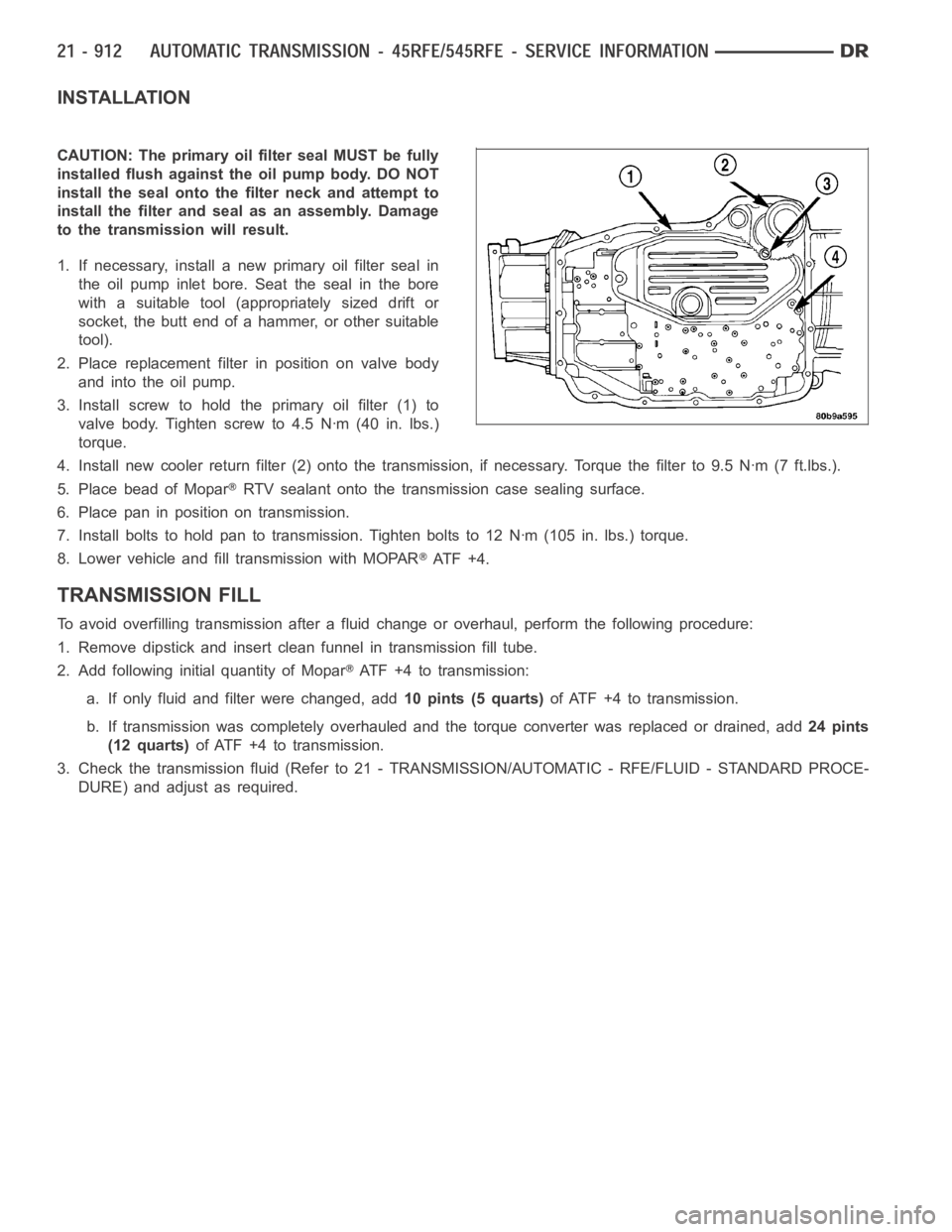
INSTALLATION
CAUTION: The primary oil filter seal MUST be fully
installed flush against the oil pump body. DO NOT
install the seal onto the filter neck and attempt to
install the filter and seal as an assembly. Damage
to the transmission will result.
1. If necessary, install a new primary oil filter seal in
the oil pump inlet bore. Seat the seal in the bore
with a suitable tool (appropriately sized drift or
socket, the butt end of a hammer, or other suitable
tool).
2. Place replacement filter in position on valve body
and into the oil pump.
3. Install screw to hold the primary oil filter (1) to
valve body. Tighten screw to 4.5 Nꞏm (40 in. lbs.)
torque.
4. Install new cooler return filter (2) onto the transmission, if necessary. Torque the filter to 9.5 Nꞏm (7 ft.lbs.).
5. Place bead of Mopar
RTV sealant onto the transmission case sealing surface.
6. Place pan in position on transmission.
7. Install bolts to hold pan to transmission. Tighten bolts to 12 Nꞏm (105 in. lbs.) torque.
8. Lower vehicle and fill transmission with MOPAR
AT F + 4 .
TRANSMISSION FILL
To avoid overfilling transmission after a fluid change or overhaul, perform the following procedure:
1. Remove dipstick and insert clean funnel in transmission fill tube.
2. Add following initial quantity of Mopar
ATF+4totransmission:
a. If only fluid and filter were changed, add10 pints (5 quarts)of ATF +4 to transmission.
b. If transmission was completely overhauled and the torque converter wasreplaced or drained, add24 pints
(12 quarts)ofATF+4totransmission.
3. Check the transmission fluid (Refer to 21 - TRANSMISSION/AUTOMATIC - RFE/FLUID - STANDARD PROCE-
DURE) and adjust as required.
Page 3487 of 5267
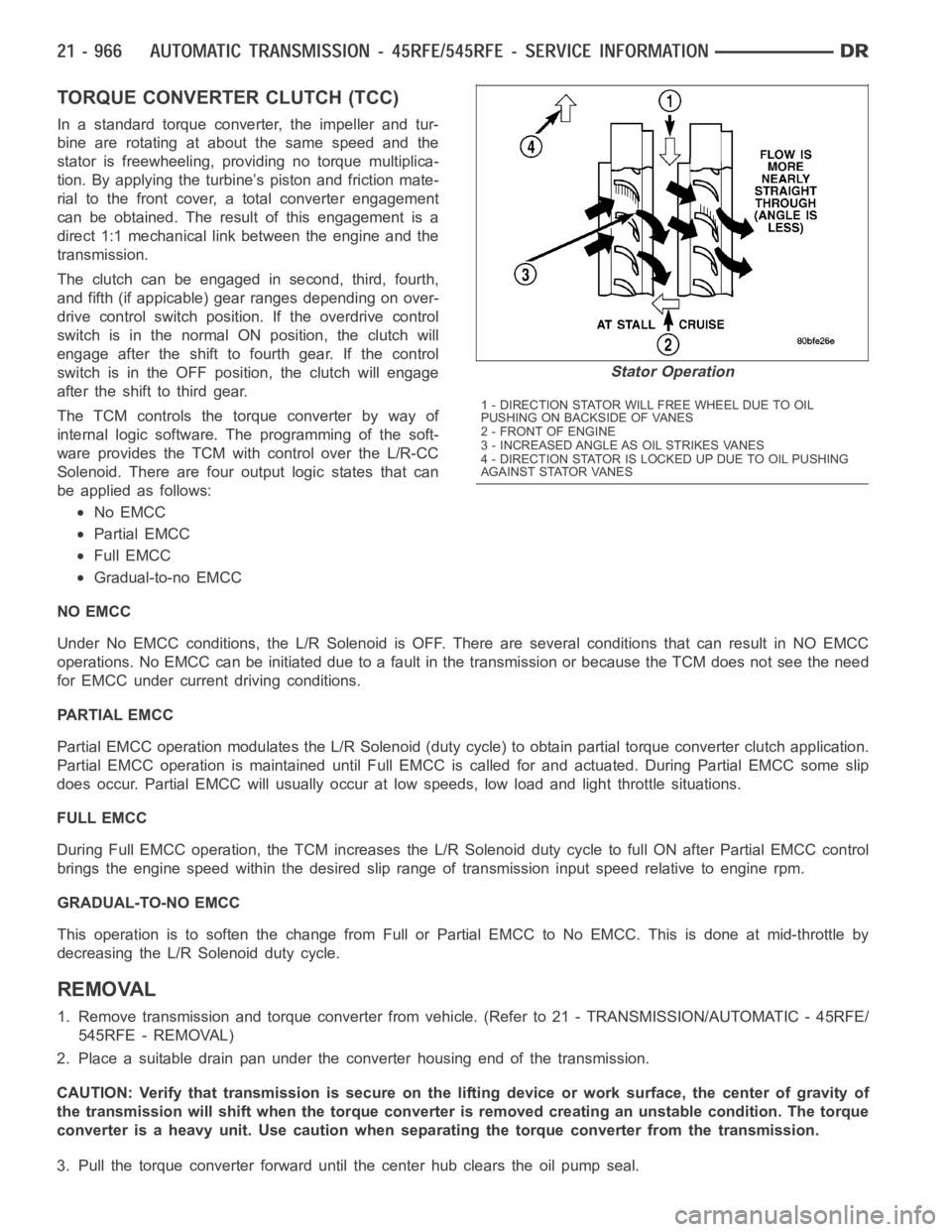
TORQUE CONVERTER CLUTCH (TCC)
In a standard torque converter, the impeller and tur-
bine are rotating at about the same speed and the
stator is freewheeling, providing no torque multiplica-
tion. By applying the turbine’s piston and friction mate-
rial to the front cover, a total converter engagement
can be obtained. The result of this engagement is a
direct 1:1 mechanical link between the engine and the
transmission.
The clutch can be engaged in second, third, fourth,
and fifth (if appicable) gear ranges depending on over-
drive control switch position. If the overdrive control
switch is in the normal ON position, the clutch will
engage after the shift to fourth gear. If the control
switch is in the OFF position, the clutch will engage
after the shift to third gear.
The TCM controls the torque converter by way of
internal logic software. The programming of the soft-
ware provides the TCM with control over the L/R-CC
Solenoid. There are four output logic states that can
be applied as follows:
No EMCC
Partial EMCC
Full EMCC
Gradual-to-no EMCC
NO EMCC
Under No EMCC conditions, the L/R Solenoid is OFF. There are several conditions that can result in NO EMCC
operations. No EMCC can be initiated due to a fault in the transmission or because the TCM does not see the need
for EMCC under current driving conditions.
PARTIAL EMCC
Partial EMCC operation modulates the L/R Solenoid (duty cycle) to obtain partial torque converter clutch application.
Partial EMCC operation is maintaineduntil Full EMCC is called for and actuated. During Partial EMCC some slip
does occur. Partial EMCC will usually occur at low speeds, low load and light throttle situations.
FULL EMCC
During Full EMCC operation, the TCM increases the L/R Solenoid duty cycle to full ON after Partial EMCC control
brings the engine speed within the desired slip range of transmission input speed relative to engine rpm.
GRADUAL-TO-NO EMCC
This operation is to soften the change from Full or Partial EMCC to No EMCC. This is done at mid-throttle by
decreasing the L/R Solenoid duty cycle.
REMOVAL
1. Remove transmission and torque converter from vehicle. (Refer to 21 - TRANSMISSION/AUTOMATIC - 45RFE/
545RFE - REMOVAL)
2. Place a suitable drain pan under the converter housing end of the transmission.
CAUTION: Verify that transmission is secure on the lifting device or work surface, the center of gravity of
the transmission will shift when the torque converter is removed creatingan unstable condition. The torque
converter is a heavy unit. Use caution when separating the torque converter from the transmission.
3. Pull the torque converter forward until the center hub clears the oil pumpseal.
Stator Operation
1 - DIRECTION STATOR WILL FREE WHEEL DUE TO OIL
PUSHING ON BACKSIDE OF VANES
2-FRONTOFENGINE
3 - INCREASED ANGLE AS OIL STRIKES VANES
4 - DIRECTION STATOR IS LOCKED UP DUE TO OIL PUSHING
AGAINST STATOR VANES